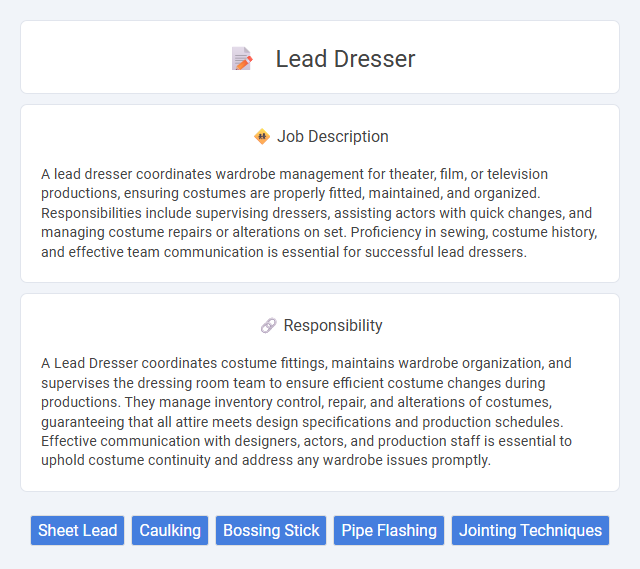
A lead dresser coordinates wardrobe management for theater, film, or television productions, ensuring costumes are properly fitted, maintained, and organized. Responsibilities include supervising dressers, assisting actors with quick changes, and managing costume repairs or alterations on set. Proficiency in sewing, costume history, and effective team communication is essential for successful lead dressers.
Individuals with strong attention to detail and physical stamina are likely more suitable for a Lead Dresser role, given the demands of managing costume fittings and ensuring flawless wardrobe presentation. Those who thrive in fast-paced, high-pressure environments with excellent organizational and communication skills probably find success in this job. Candidates with limited experience in costume management or difficulty multitasking may face challenges adapting to the responsibilities of a Lead Dresser.
Qualification
A lead dresser must possess extensive knowledge of costume design and garment construction, often backed by a degree in fashion design or theater arts. Proven experience in managing wardrobe teams and coordinating costumes for live performances is essential. Strong organizational skills, attention to detail, and the ability to work under pressure in fast-paced environments are critical qualifications for this role.
Responsibility
A Lead Dresser coordinates costume fittings, maintains wardrobe organization, and supervises the dressing room team to ensure efficient costume changes during productions. They manage inventory control, repair, and alterations of costumes, guaranteeing that all attire meets design specifications and production schedules. Effective communication with designers, actors, and production staff is essential to uphold costume continuity and address any wardrobe issues promptly.
Benefit
Lead dressers likely enjoy benefits such as competitive salaries, health insurance, and opportunities for career advancement within the theater or film production industries. Access to networking opportunities and skill development workshops may also enhance their professional growth and job stability. These benefits probably contribute to increased job satisfaction and long-term employment prospects.
Challenge
The lead dresser role likely involves navigating tight schedules and high-pressure environments to ensure wardrobe precision for each performance. Managing a team and addressing last-minute costume issues may present ongoing challenges that require quick problem-solving skills. Success in this position probably depends on maintaining organization and adaptability in fast-paced settings.
Career Advancement
Lead dressers play a crucial role in film and theater productions by managing costume teams and ensuring wardrobe continuity, which enhances their leadership skills and industry reputation. Their experience in coordinating complex costume designs and maintaining detailed records opens opportunities for advancing to costume designer or wardrobe supervisor positions. Strong communication and project management abilities gained as a lead dresser contribute significantly to career growth within the entertainment and fashion industries.
Key Terms
Sheet Lead
Sheet Lead dressers specialize in preparing and aligning lead sheets used in various industries such as construction and manufacturing, ensuring precise measurements and cuts for waterproofing and radiation shielding applications. Their expertise includes interpreting technical drawings and selecting appropriate lead thicknesses to meet project specifications. Mastery in handling and shaping heavy lead materials reduces waste and enhances installation efficiency.
Caulking
Lead dressers specializing in caulking supervise the application of sealants to joints and seams in masonry or concrete structures to prevent water infiltration and enhance durability. They coordinate teams responsible for surface preparation, material selection, and precise application techniques that ensure airtight and waterproof seals. Expertise in various caulking materials such as silicone, polyurethane, and acrylic elastomers is critical to optimizing structural integrity and longevity.
Bossing Stick
A lead dresser expertly uses a bossing stick to smooth and shape metal surfaces, ensuring flawless contours in theatrical costume design or metalworking. This essential tool allows precision in creating detailed textures and bends, enhancing the quality and durability of the finished product. Mastery of the bossing stick significantly improves efficiency and accuracy in fabric or metal manipulation during the dressing process.
Pipe Flashing
Lead dressers specialize in crafting and installing pipe flashing, a critical component for waterproofing around pipe penetrations on roofs and walls. Expertise in shaping lead sheets to precisely fit complex pipe contours ensures long-lasting protection against water ingress and structural damage. Mastery of traditional leadworking techniques combined with knowledge of roofing standards enhances the durability and effectiveness of pipe flashing installations.
Jointing Techniques
Lead dressers specialize in precision jointing techniques essential for creating seamless roof coverings and lead flashings. Mastery in methods such as double roll joints, lap joints, and single roll joints ensures weatherproof and durable seams that prevent water ingress and maintain structural integrity. Expertise in handling lead sheet and executing clean, tight joints enhances both the aesthetic and functional quality of roofing and architectural leadwork.
 kuljobs.com
kuljobs.com